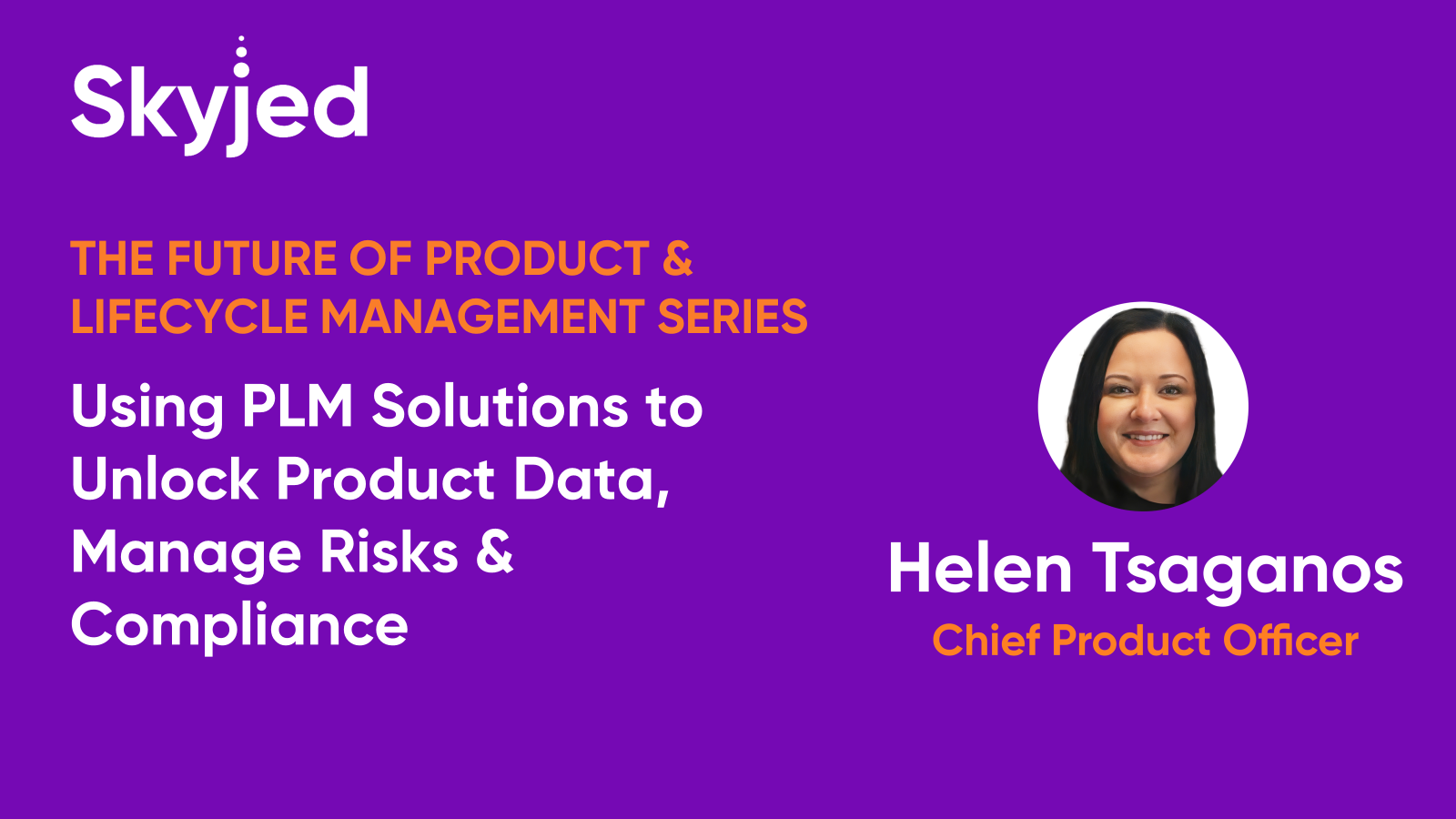Using PLM Solutions to Unlock Product Data, Manage Risks & Compliance
by Helen Tsaganos

Welcome to our blog series, Unlocking the Future of Product and Lifecycle Management (PLM).
As the Chief Product Officer at Skyjed, I'm excited to guide you through the power of Product Lifecycle Management (PLM) solutions. This series will delve into the critical aspects of modern product management, focusing on lifecycle management, efficiency, risk management, and seamless collaboration across supply chains.
Using PLM Solutions to Unlock Product Data, Manage Risks & Compliance
In today’s evolving business landscape, organisations across every sector are finding that traditional methods of product management no longer suffice.
Product Lifecycle Management (PLM) solutions are emerging as a key approach for monitoring product data and key performance indicators, streamlining compliance, managing risks, and speeding up the process of bringing new products to market.
What is PLM?
PLM is a strategic approach that manages the entire lifecycle of a product from inception, through design and launch, to service, optimisation, and disposal.
PLM solutions integrate people, data, processes, and business systems, providing a product information backbone for companies and their extended enterprise.
Centralising Data for Efficient Management
One of the primary benefits of introducing a PLM solution is centralising product information in one easily accessible platform.
This functionality is invaluable for managing complex datasets across teams, ensuring everyone has the latest product information, specifications, performance data, and compliance checks, all with a full audit trail and version history.
With tools that aid in formulating product designs, product information, and data sheets, assessing risks, and automating monitoring and analysis including regular milestones or important check-ins, PLM allows organisations to streamline processes that traditionally require extensive resources and time.
Reducing Manual Workloads and Enhancing Creativity
The adoption of PLM solutions can significantly reduce the need for manual tasks such as calender management and meeting critical deadlines, data entry, supplier management, and updating product details.
By automating these routine processes with reminders for recurring check-ins, teams can redirect their efforts towards more innovative and strategic aspects of lifecycle management.
This shift not only accelerates the development cycle but also enhances the quality and safety of product portfolios.
Benefits for Time and Cost
Organisations that have integrated Product Lifecycle Management (PLM) solutions report substantial savings in both time and efficiencies gained, faster decision-making, and administration. These solutions provide rich insights that facilitate collaboration and data-driven decision-making.
Organisations have reported reductions in administrative and monitoring performance time by as much as 50% and up to 90% in reporting and analysis. PLM enables any industry to reduce time-to-market and improve product quality and governance while maintaining a stronger focus on strategic priorities.
Managing Product Risks: Why It’s Important
Managing product risks is critical for ensuring that products are safe, reliable, and compliant with regulatory standards. PLM solutions help organisations identify, assess, and mitigate risks throughout the product lifecycle. By providing comprehensive visibility into product data, PLM enables teams to detect potential issues early, reducing the likelihood of costly recalls or compliance breaches.
How PLM Solutions Manages Product Risks
Risk Identification and Assessment: PLM systems centralises all product-related data, making it easier to identify potential risks at various stages of the product lifecycle. This includes design flaws, material inconsistencies, and compliance issues.
Risk Mitigation and Monitoring: PLM solutions provide tools for team collaboration, risk prioritisation, continuous risk monitoring, and effective management. Automated risk indicators and alerts including automated comprehensive risk dashboards ensure that emerging risks are promptly identified and addressed, enabling swift implementation of corrective actions.
Benefits and Use Cases of Risk Management in PLM
Enhanced Compliance: By maintaining a thorough and up-to-date audit trail of all product data and compliance checks, PLM helps organisations adhere to industry regulations and standards.
Improved Product Quality: Continuous monitoring and risk assessment lead to higher product quality and reliability, enhancing customer satisfaction.
Cost Savings: Early detection and mitigation of risks prevent costly recalls, rework and reputational damage, resulting in significant cost savings.
Beyond Risk Management and Compliance: A Tool for Innovation & Growth
A PLM solution is invaluable for ensuring that products meet and monitor for regulatory standards and obligations, thereby minimising the risk of non-compliance.
However, its benefits extend far beyond risk management and compliance.
It also facilitates the design and testing of new ideas and tracks their outcomes, providing insights that prevent the recurrence or learnings of past failures. This enablement is particularly useful for industries where innovation cycles are rapid, and market demands frequently change.
Consider a global or national provider of products or services with an extensive range, managing hundreds of design specifications and compliance data points with a high potential for error with their internal or external supply chain.
With a PLM solution, all relevant data is streamlined and centralised, making it easier to share information with supply chain partners automatically and reducing the time required for updates and checks.
By automating time-consuming tasks, reducing costs, and improving accuracy, PLM solutions allow companies across industries to focus on innovation and strategic growth.

Watch our 1-minute Skyjed overview video here
Skyjed’s AI-powered end-to-end lifecycle and governance platform is mission control for product management. Bringing together every data point across your entire product portfolio and lifecycle into a single source of product truth, it gives our clients a new perspective to make more strategic lifecycle decisions to launch, monitor, optimise, and win with brilliant products.
Our industry-leading platform has received numerous awards and recognition from clients and industry bodies, demonstrating our commitment to innovation and excellence.



